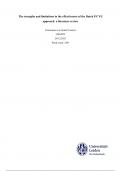The strengths and limitations in the effectiveness of the Dutch P/CVE
approach: a literature review
Extremism in a Global Context
s2839032
24/12/2023
Word count: 3291
, Introduction
After 9/11, and with an increasing focus on Islamist terrorism, counterterrorism research and
policies surged globally, specifically in Western nations (Groothuis, 2023). It was not until
various large-scale attacks such as the London bombings (2005) and the Madrid attacks
(2004) that countries started concentrating more on the phenomenon of ‘homegrown’
extremism (Shanaah & Heath-Kelly, 2023). This new policy field became known as
Preventing and Countering Violent Extremism (P/CVE) and is based on a ‘softer’ approach
to countering homegrown terrorism, where policies focus on preventive integration and
rehabilitation (Abbas, 2019; Shanaah & Heath-Kelly, 2023).
Identifying violent extremism as a substantial threat to Dutch democracy and security,
many diverging measures and laws have been implemented over the years. The rapid
expansion of this policy field, however, has also brought with it many complications. This
paper will, therefore, provide a literature review that critically assesses the current P/CVE
policies used in the Netherlands by determining key approaches, strengths and limitations.
Furthermore, it considers alternative approaches and discusses recommendations brought
forth by academics. It will broadly answer the research question ‘How effective is the Dutch
approach to violent extremism?’ but also look at research gaps in the literature.
Because Dutch policies use the concepts (violent) extremism and radicalisation
interchangeably, and because it refers to far-right extremism, Islamist extremism, Salafism or
Jihadism predominantly (NCTV, 2022), this paper will also utilise these terms, while
simultaneously acknowledging their complications. The paper will first look at the literature
that discusses the emergence of the Dutch approach. Then, it considers current definitions
and approaches, both nationally and locally. It, lastly, encapsulates frequently stated critiques
of the approaches and discusses proposed alternatives.
The emergence of the ‘broad’ approach
There is a broad consensus in the academic timeline that the first occurrences of
counterterrorism developments in the Netherlands transpired in the early 1970s when there
were multiple hostage-takings and train hijackings by Moluccan groups (Hameeteman, 2011;
van Riezen & Roex, 2012; Vliek & de Koning, 2023; Wittendorp et al., 2017). Rather than
responding with violence, Dutch security officials negotiated with the offenders to
de-escalate the situation (Wittendorp et al., 2017). Although terrorism as a public policy
domain was absent, these attempted dialogues were the groundwork of what became known
, as the ‘Dutch’ or ‘broad’ approach (Eijkman et al., 2012; de Graaf & de Graaff, 2008; Vliek
& de Koning, 2023: Wittendorp et al., 2017;).
Major changes occurred in the counterterrorism field after the 9/11 attacks (Eijkman
et al., 2012; de Graaf, 2014; Vliek & de Koning, 2023), and only a month later the
government presented its first Counter-Terrorism and Security Action Plan (Wittendorp et al.,
2017). A major catalyst in Dutch counterterrorism development was the murder of filmmaker
Theo van Gogh in 2004 by an Islamist extremist, highlighting the emergence of home-grown
terrorism and extremism in the Netherlands (de Graaf, 2014; de Graaf & de Graaff, 2008).
The murder led to new radical counterterrorism measures (de Graaf & de Graaff, 2008; Vliek
& de Koning, 2023), one of which was the 2004 Crimes of Terrorism Act that made terrorism
officially a punishable offence (de Graaf, 2014).
Whereas criminal prosecution was the primary concern in early counterterrorism
policy and the causes of terrorism were rarely addressed (Abels, 2012), studies identified a
change in 2005 when a new policy, “Radicalism and Radicalisation”, was introduced,
outlining the confrontation of radical individuals, the promotion of societal resilience and
increasing integration between communities and society (Eijkman et al., 2012; Wittendorp et
al., 2017). The priority shifted from protection and prosecution to preventing attacks and
identifying radicalised individuals (Akerboom, 2003).
While other countries, such as Germany, implemented harsh counterterrorism
measures that closed options for political debate (de Graaf, 2009; van Riezen & Roex, 2012),
the Dutch counterterrorism approach became known as comprehensive, and sometimes
labelled as ‘soft’. This approach encompassed repressive measures to combat terrorists, as
well as preventive and nonviolent initiatives to emphasise the “integration of radical political
protest within the Dutch democratic system, even if these protests were pursued by violent
means” (de Graaf & de Graaff, 2008).
Wittendorp et al. (2017, p.93) highlight that counter-extremism policies in the
Netherlands “initially focused heavily on promoting the integration of minorities”. Policies
between 2007 and 2011 mainly concentrated on homegrown Islamic radicalisation (Eijkman
et al., 2012; Wittendorp et al., 2017), but in more recent years, scholars identified a shift
away from homegrown extremism towards more global forms (Eijkman et al., 2012; Vliek &
de Koning, 2023). Fear arose as Islamic militant groups formed around and after 2010 and
P/CVE measures reformed when Islamic State was at its all-time high (de Koning et al.,
2020).





